Disclaimer
The Dover Public Library website offers public access to a wide range of information, including historical materials that are products of their particular times, and may contain values, language or stereotypes that would now be deemed insensitive, inappropriate or factually inaccurate. However, these records reflect the shared attitudes and values of the community from which they were collected and thus constitute an important social record.
The materials contained in the collection do not represent the opinions of the City of Dover, or the Dover Public Library.
1990 Heritage Walking Tour
Heritage Walking Tour Booklet June 1990 by the Dover Heritage Group, Dover, NH, c. 1990.
In 1978, a group called Dover Tomorrow formed to promote the growth and prosperity of Dover. A subcommittee was tasked with promoting “appreciation of Dover’s heritage”. The Lively City Committee created the first Heritage Walk the next year. It was so popular that new tours were created every year, and held through 2007. By 1982, Dover’s historical society, the Northam Colonists, had taken over the research and creation of the Heritage Walking Tour Booklets. The information on the page below is a transcription of the original Heritage Walking Tour Booklet. The Library has a complete set of the Heritage Walking Tours if you would like to see the original booklets.
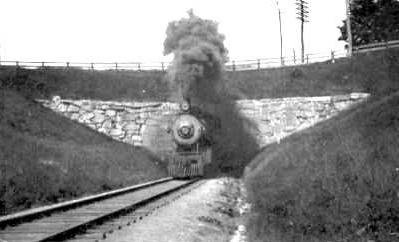
When the first Boston & Maine locomotive steamed into “Coffin’s Cut” in Dover on September 1, 1841, great crowds assembled here on Arch street. Most had never seen a train before and one man was heard to remark, “You can’t fool me! I know there’s a horse in there somewhere.”
N.H. had granted the B & M permission to cross into the state from Haverhill, Mass. And in 1838, Dover voters assented to the tracks passing through their town. The Dover Gazette lobbied against it: the railroad would put men out of work who rode the stages and coasting vessels. Dover would “be turned into a town of idlers, under a tyrant’s power.”
But quite the opposite, the railroad gave a boost to Dover’s industries and employment outlook. This year’s Heritage Walk area of Arch, Washington Cushing and Silver developed, in large part, because the railroad broadened Dover’s markets.
2 Arch Street
Built on land originally belonging to the Abbott Estate, this home, ca. 1917, has had five owners. The land was purchased at the turn of the century by Walter Chesley who sold it in 1903 to Charles and Adah Canney. The lot was bought in 1915 by Clarence and Ella Keyes and the house was built soon after. In 1943, Bessie Maguire paid $2500 for the property and sold it two years later to Joseph and Winifred Moore. Elton T. Vigent bought it in 1960 and sold it in 1987 to current owners, Larry and Patricia Tatro.
9 Arch Street
In 1885, Levi Elder sold this land to Lyman Parson, a carpenter, for $200, and by 1888 the Parsons family was living here. Lyman died in 1891, his wife Elizabeth died in 1912, but the home remained in the Parsons family through daughter Myra and grandsons Leo and Bernard until 1971. It was then purchased by the Peschke family and later owned by Bernard F. Ryder. The house is now owned by an East Kingston resident.
10 Arch Street
At one time called “the handsomest house in the city,” the Abbott/Ross mansion is currently divided into apartments. The large estate was constructed ca. 1887 by Isaac F. Abbott, cashier of the Dover National Bank. Abbott was born in Dover in 1842 and started his career as a clerk at D. Lothrop’s. He worked as a bookkeeper for the bank and rose to become head financial officer. When he assumed this position in 1888, Abbott’s salary was $3000 per year and many locals questioned how he could afford such a magnificent house. Abbott let on that his wife’s family had left her a considerable fortune.
Wife Lizzie Abbot died in 1892 leaving Isaac to care for his children Bert, Cushman, and Clara. Abbott continued work at the Dover National Bank and the home’s expenses continued to rise. One newspaper account of the time said, “the buildings outside are substantial but do not five any indication of the prince-like furnishings inside. Elegant furniture, costly draperies, carpets that give back no sound after a footfall, makes every room handsome in the extreme.”
Then in 1895, Dover was stunned. State bank examiners discovered major discrepancies in the bank’s accounting records. Over $80,000 was missing and Isaac Abbott became the chief suspect. Headlines in the newspaper speculated that it was the bank’s money, not Lizzie’s supposed inheritance, that had built the mansion. On January 14, 1895, just before officers could arrest him, Isaac Abbott went to an upstairs bedroom and fatally shot himself.
The Dover National Bank was in dire financial straits. Able to pay its panicked depositors only $.50.-60 on the dollar, the bank went into receivership and soon closed. In 1901, an Isaac Abbott estate plan was devised to recoup some of the embezzled funds. The plan showed a new street to be developed here perpendicular to Arch Street, and twenty new house lots in “Abbott Field.’ But this plan never materialized and the time was sold in 1907 to Lincoln K. Ross who owns ladies’ furnishings and corset store at 376 Central Ave. After Ross’ death in the mid-40s, his widow Grace lived here to the late’60s. Present owner is Alfred Catalfo, Jr.
20 Arch Street
In 1913, George Varney, owner of a drug store on Washington Street, purchased several lots in “Abbott Field” and built this large home. Varney had been a prominent local merchant for 40 years, a member of the State Legislature, the Dover School Committee, and a Public Library trustee. He retired in 1919 at age 65 and died in 1920. Son Lucius E. Varney, a patent attorney in New York City, inherited the home with his mother, Helen. Mrs. Varney died in 1933, and the estate, sold the time to Alfred Catalfo, Jr. It remains the Catalfo home today.
35 Arch Street
This New Englander was constructed about 1867 by Albert A. Pike, a shoe manufacturer. After his death in 1899, his daughter Frances sold the home to Frank P. Sheppard who resold the property to Cora L. Burleigh. In 1924 it was purchased again, this time by Herbert C. Hodgdon, a metalworker. The home was inherited in the late 1940s by his daughter Zilla M. Potterton. Mrs. Potterton sold much of the property acreage for house lots ca. 1947 and 1954. Present owner is Dorothy Crawford.
37, 39, And 43 Arch Street
These four homes were built during the period 1933-34 by architect Willis E. Littlefield and his father Adelbert, a contractor. Littlefield purchased the lots in 1930 from the estate of Annie Brewster who had owned the Coffin house.
At 37 Arch Street resided Miss Edith Chase and her mother. Miss Chases’s deceased father had been a Baptist minister. Current owners are Reynolds and Janet Perry.
Willis Littlefield constructed the house at 39 Arch for himself. It was sold to Molly Goodwin, a widow whose husband had been a Civil war veteran and had died many years before. Upon her death, a nephew, Paul Knowlton, resided here for many years. In 1963, this home was purchased by Anita and Gerard St. Laurent who reside there today.
The home at 41 Arch Street was built for Joe and Olive Piper, long-term Public Service employees. The house was sold at Olive’s death in 1985. Current owner is Eleanor Bruce.
George and Jane Ann Sherwood reside the house at 43 Arch. It was custom built in 1934 for Mrs. Sherwood’s father, Edward Loughlin and for her uncle, Patrick Loughlin, as a side-by-side duplex. Both of the men were employed for many years at the M&M bakery. Edward lived in #43 with his two sisters and brother white Patrick Loughlin, his wife Helena, and children Anne and Bernard lived on the other side, #45. In 1978, one remaining cousin’s share of #45 was sold to the Sherwoods.
46-48 Arch Street
The James Moscato family had owned this yellow duplex since 1953. The home was built about 1865 by two Barrington natives, Jonathan K. Felker and George Hodgdon, both of whom lived in it only a few years. Felker, a Civil War veteran who was disabled from a lightning bolt while in service, worked in the printery and as a carpenter. Hodgdon was a farmer who sold his half of the property to another Barrington resident, in John Q. A. Swain, in 1872. Swain owned the home until he died in 1912, but lived here only sporadically, spending several years back in his native Barrington. His share of the house then passed to his daughter Adah Canney and grandson Earl.
Jonathan Felker moved to Highland Street in 1875, but retained ownership of his half of this house too. After Jonathan’s death in 1914, the Felker share passed to his son, Levi F. Felker. He sold in 1949 to Orimal and Hazel Garside.
49 Arch Street

The Coffin House is one of the oldest houses standing in Dover today. Several sources date its origins back to builder Tristram Coffin and 1720. The last Coffin to occupy it was Elizabeth who was born here in 1785. She was a lineal descendant of Peter Coffin whose garrison was attacked by Indians during the 1689 massacre. When Elizabeth died at age 68 on 1853, she had observed (and strongly resisted) remarkable changes and overwhelming growth in her part of Dover. During the 18th century and the first half of the 19th, the Coffins were the only residents in this part of town. The land was all agricultural and farmers lived “up the Tole End to the heath.” Then the mills stirred up Dover: the population doubled in the years between 1820-1826, old roads were ordered straightened and widened, and new roads were petitioned. In 1821, Dover selectmen ordered a new road through the Coffin land which extended from this house down Log Hill to the Cocheco River. The Coffins fought the decision in the courts and were successful until 1824 when the road was finally commissioned over their objections. The Tole End farmers, tired of circling all the way down Arch (then Tole End), then onto Silver, then onto Central to get into town, withdrew their support for the Coffins. By 1826, the new shortcut to town was being built from Central Square and the Coffins ended up parting with 615 rods of land. By 1843, the west end of the developed street reached the junction with Green Street and by 1848 Washington Street stretched halfway up Log Hill. The upper end of Coffin Road remained “an outpost of civilization, a lonesome country road.” Mercifully, the real residential growth on in this area surrounding Elizabeth’s house didn’t occur until 1860-1870, a decade after her death.
From 1867-1898 the Coffin house was owned by John f. Hayes and until 1928 by the I. Smith and Annie Brewster family. It was sold in 1930 to Matthew Cavanaugh and in 1935 to George O’Neil. Present owner is Ken O’Neil.
282-284 Washington Street
This duplex, currently owned by Robert H. and Maureen Marshall, was built on land originally owned by John Hayes. In 1904, Hayes sold the lot to Charles A. Faxon who lived at #256. The home was built between 1905 and 1916. Mrs. Faxon’s descendant, Dorothy E. Ham sold to the Marshalls in 1963.
281 Washington Street
Constructed between 1878-1880, this residence was home to J. Burleigh Pinkham, an overseer for the Cocheco Mills, through 1895 and for his widow, Hannah Jane, until 1900. Burleigh Pinkham had worked at the mill since the age of seven and retired in 1891, a span of over 60 years on the job. He was also the founder of the Dover Cornet Band.
Mrs. Pinkham sold the house to Henry G. Hayes who owned a bottling business on Chestnut Street with his brother. By 1905, Henry had abandoned bottles and was selling stoves at 455 Central Ave. Along with his son Ralph, Henry Hayes expanded to include tinware, pumps, lead pipe, sheet iron, and tin roofing. After Henry’s death in 1930, Ralph Hayes occupied the family home and ran a plumbing business until about 1950. Since then the owner has been John R. Bernier.
277 Washington Street
This house, initially occupied by Jacob Foss, was built ca. 1871-1874. Foss had many occupations during his lifetime: boxmaker, fireman, night watchman at the Cocheco Mfg. Co., and near the end of his life, was simply “laborer.” After Foss’ death in 1913, his nephew Arthur L. Snell loved here, but the house was sold ca. 1920 to Charles E. Cate, owner of E. Morrill Furniture. During the late 1940s the home was purchased by the Arthur E. Bowles family. It has been owned since the late ‘60s by Mr. and Mrs. Harry N. Griffin.
276 And 278-280 Washington Street
One of the oldest properties on this portion of Washington Street, these two homes, originally one large house and a barn, are now apartments and a market. Both are ca. 1859. Greenleaf Clark, the original owner with wife Aphia, was a weaver and overseer in the mills. Mr. Clark died in 1874, but Aphia remained here until her death in 1890. In 1898, Frank H. Clark sold the home to Lizzie McDaniel for $3600, and McDaniel heir Bertha McDaniel Davis sold the property in 1945 to Raymond Demers. The Demers family operated a meat market here for many years and sold the property in 1981.
274 Washington Street
Currently owned by former Dover residents now living in Florida, this residence was built ca. 1871-1877. During the 1880s and ‘90s, it was the home of Widow Betsey Caswell. Caswell heirs sold the home to the Pacific Mills, who in turn, sold it to Isaac and Maria Couser in 1928. Norman and Miriam Fine purchased the house in 1952 from Mrs. Couser
270 Washington Street
This home was the residence of Episcopal Church minister John B. Richmond for whom Richmond Street was named. Rev. Richmond was pastor of St. Thomas Church from 1868-1876 and the house was constructed ca. 1867. Originally land owned by Greenleaf Clark, the lot with buildings was sold in 1867 to Israel Ham for $4000. Ham sold the premises in 1869 to Deborah Richmond, the minister’s wife, $5200.
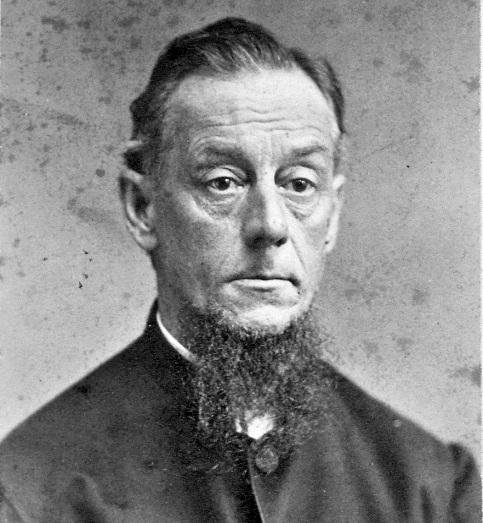
John B. Richmond
During his rectorship, Rev. Richmond presided over major interior alterations to the wooden Central Street church and enlarged its seating capacity. He resigned from his post April 29, 1876. The home was sold to Amanda Pickering in 1887 and it remained in this family until 1940. The present owner, Mary Theodoras, acquired the property in 1955.
269 Washington Street
Built between 1878-1880, this mansard-roofed Victorian was first owned by Mrs. Louisa Chadwick and son William. William K. Chadwick was the Dover City treasurer from 1896 until his death at age 69 in 1915 and resided here all his life. His mother survived him and lived here through 1917. During the 1920s, the home was purchased by Frank and Mabel Halliday, and later, in the 1950s, by the Robert Peters family, Now apartments, the building is owned out-of-town.
265 Washington Street
Gustavus Horne, a clerk at the Dover National Bank, built this home ca. 1867 but sold it in 1871 to Moulton B. Smart and his wife Ann. Smart died in 1875 but his widow remained here until 1897. During the early 1900s it was owned by Nellie and George Lemoyne, but it was sold in 1917. It was then owned by Frank and Minnie C. Gray, then by Frank and Olice S. Gray, then by the Soteropoulus family. The Hearn family purchased the house in 1985.
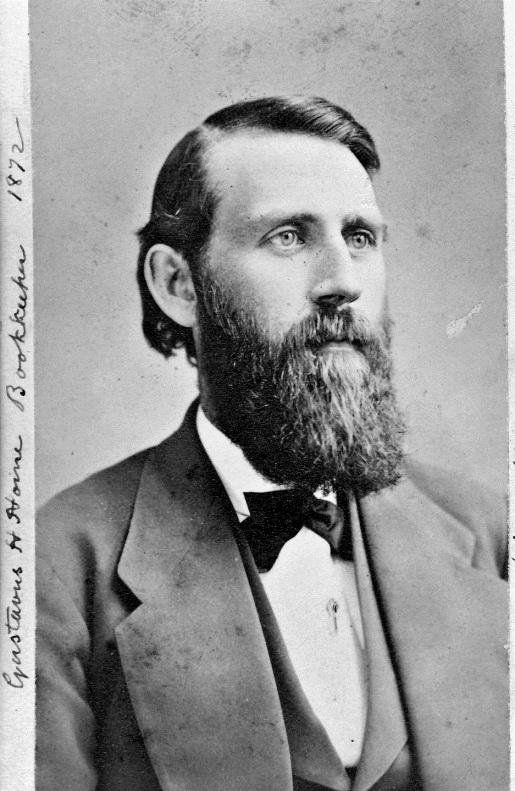
Gustavus Horne
261 Washington Street
This residence was built before 1859 for Joseph T. S. Libbey. Libbey moved to Dover in 1847 to become foreman at the Dover Gazette. In 1849, he held the same position for the Morning Star. With partner John R. Varney, Libbey purchased the Dover enquirer in 1868 and became that paper’s publisher. In 1880, Libbey and Varney also acquired the Dover Daily Republican. Joseph Libbey retired from journalism in 1886 but continued to work as the Station Agent for the Folsom St. Station of the B&M. Libbey was also the father of four, a Civil War veteran, a representative to the N.H. legislature 1878-1880, clerk of the Dover Common Council for 7 years, and selectman from Ward 3 for several years. He was also a member of the G.A.R., the Sawyer Post, the Red Men, the Masons, and the Knights of Pythias. After his death in 1907, the house belonged to a Lemoyne family for approximately 23 years, then to the Frewen family for about 26 years. It has been owned by Spero Theodoras since 1966.

Joseph T.S. Libbey
255 Washington Street/ The Varney School
The law firm of Burns, Bryant, Hinchey, Cox and Schulte, P.A., currently occupies the brick edifice built in 1861 as the Washington Street Primary School. Thomas H. Cushing donated the land to the city and the schoolhouse was constructed with four classrooms able to house 188 young scholars. In 1882, the school was renamed the Varney School in house of Judge John R. Varney. Varney, an ex-math professor at Dartmouth, had been a prominent local lawyer, editor, politician, and school board member in Dover. He died in the 1882 fire that destroyed the Washington Street Baptist Church.
In 1890, the Varney School was designated as a training school for high school graduates wishing to become teachers; many young Dover women started their teaching careers in the Varney classrooms. The Varney School closed in 1953 when the new Woodman Park School opened and by 1958 had become the offices of lawyers Burns, Calderwood, Bryant and Hinchey.
258-260 Washington Street
Built during the mid-1870s, this house, now a duplex, was the home of Benjamin Mason Nealley (1811-1888), a mill overseer who had moved to Dover in 1824. Nealley soon moved away to accept manufacturing jobs first in South Berwick, then in Laconia, and later in Salem, Mass. In 1877, his health failing, Nealley retired back to Dover and this homestead. Nealley had been active in the anti-slavery movement, acting as a “conductor” on the Underground Railroad that passed through N.H. to Canada; he was also a radical temperance advocate.
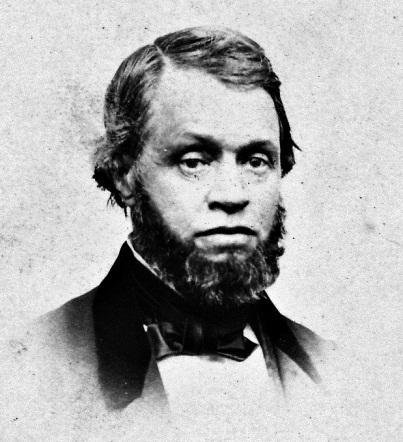
Benjamin Mason Nealley
His eldest son Benjamin Franklin Nealley (1839-1910) started a dry goods store at age 18 and continued for 36 years as a retailer. B.F. Nealley inherited the home in 1888.
B.M. Nealley’s youngest son John Haven Nealley (1853-1928) worked as a clerk in his brother’s store until 1893 when he purchased the business and B.F. retired. Both Nealley brothers served as mayors of Dover (B.Frank 1889-1990; John 1904-1905) and as New Hampshire State Senators. John H. Nealley married Thomas Cushing’s daughter Emma in 1877 and resided at #230.
In 1892, B. Frank Nealley sold this house to Frank Stone who resold it in 1907 to Charles A. Faxon. Faxon’s nephew, J. Herman Ham, inherited the house in 1913 and it remained in that family until 1968. Present owner is Earlon Cheney.
254-25 Washington Street
This large white duplex was constructed ca. 1876-77 by Charles A. Faxon, grocery store owner and lumber dealer. For the first decade after building his house, Mr. Faxon loved to sit in a large window and watch this activity down Washington Street at Central Square. After Richard Ross built his home next door at #250, Faxon’s view was still unimpeded; all was well. Then an argument, reasons unknown, erupted between the two men and as a result of this feud, Mr. Ross erected a high fence between the two houses, completely cutting off Faxon’s view down the hill. Ross and Faxon never spoke again. When Richard Ross died in January 1897, neighbors remarked that the fence came down next spring.
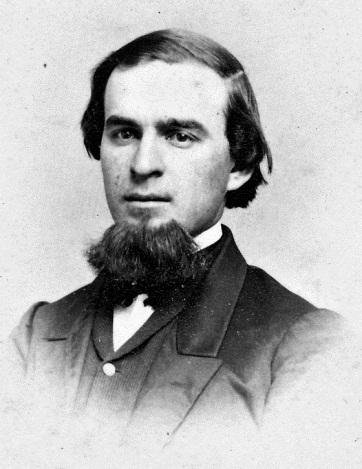
Charles Faxon
Charles died in 1910; wife Ellen in 1913. Faxon’s nieces Grace Perkins and Hittie Ham, lived in the house during the ‘50s; in the ‘60s it was sold to the Leon Yeaton family by Dorothy Ham and in 1970, to residents of Durham.
250 Washington Street
Richard Ross, master mechanic at the Cocheco Print Works from 1846-1868, purchased this lot on the corner of Lexington Street in 1880 when he retired from a job in Massachusetts. Ross had always liked Dover during the 22 years he’d lived here and decided to make it home once more. At age 63, he moved back here and built this home ca. 1885. Ross served as a two-term mayor of Dover, 1885 and 1886, and lived here until his death in 1897. His wife Dorcas remained here until she died at age 88 in 1902. The house was sold to a physician Edward C. Batchelder (1875-1952). The doctor had moved to Dover in 1906 and established a practice in the Masonic Temple. The doctor’s daughter Edna married Melvin Richardson, son of City hall architect J. Edward Richardson, and the young couple lived here also from about 1933. Mrs. Richardson is still the current owner and occupant.
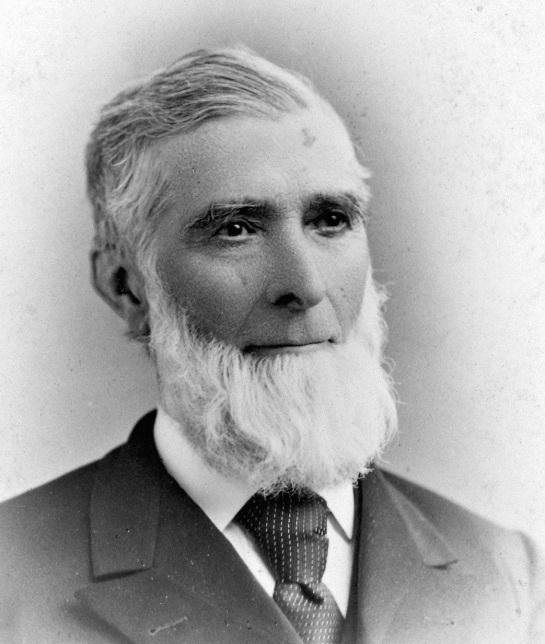
Richard Ross
247-249 Washington Street
In 1878, on this land previously owned by Thomas H. Cushing and later by Almanzor Towle, William B. Twombly built this duplex. Twombly was a peddler and a patent medicine dealer who died shortly after the house was built. Widow Ann Twombly lived here until 1908 and the property sold to Frank Bennett. Dr. Edward Batchelder purchased the home in 1928 and the doctor’s daughter, Edna Richardson, sold it in 1971.
243 Washington Street
This New Englander, built for Hanson O. Reed, was built in 1878. Reed worked as a weaver and a loom-fixer for the Cocheco Mfg. Co. and purchased this lot from Alamanzor Towle. After his death in 1916, his widow Mary Helen lived here until 1929. At that time, this house was also purchased by Dr. Batchelder. It too was sold by Edna Richardson in 1971.
235, 237-239, And 241 Washington Street
These three homes were the property of a farmer Almanzor Towle. Towle came to Dover in 1843. He owned a great deal of land throughout this part of town.
The house at 235, situated back from the street at the end of Towle’s Lane, was built between 1878-1888. Towle had purchased this land from the Cushing estate and farmed the down to the river. The Towle family did not live in this house, but rented it to various businesses such as the Cocheco Blacking Co. And the Dover Steam Carpet Cleaning Works. Almanzor’s son Herbert C. Towle sold the house in 1922 to Irving and Maude Towle and in 1951 the property passed to the Towle’s daughter, Eleanor Bohan, who still owns the house.
Another Almanzor Towle property, the house at 237-239 was lived in by the Towle family from at least 1892. After Almanzor’s death in 1910 at age 78, son Herbert sold it to Clarence and Lillie Prout who sold it to Edwin J. York in 1933. York shortly resold the home to Dr. Batchelder. Edna Richardson, Batchelder’s daughter, sold the home in 1969. The house is currently owned out-of-state. This property, too, housed several small businesses over the years: in 1898 C.E. Brewster Company, wholesale druggists and patent medicines operated from the rear side; from 1909-1913 the National Biscuit Company, and in 1921, Oscar Young sold wood here.
The home at 241 Washington Street, the third of Almanzor Towle’s properties has been in the Robert B. Young family, the current owners, for over 70 years. Prior to 1920, Herbert E. Towle owned this house, but rented it for many years to William Pinkham and daughter Mary, a Varney schoolteacher.
233 Washington Street
This home, built for Joseph and Jane Bedell ca 1858, remained in the same family for over 110 years. Bedell came to Dover in 1845 at age 21 to start a painting business. His daughter, Olive J., married Sumner W. Hatch, and their children Olive E. and Alden S. Hatch inherited the house. Alden was vice-president of Ham the Hatter, milliner on Central Ave. Olive lived here until her death in 1975.
227-229 Washington Street
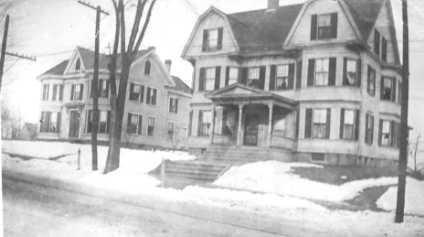
This side-by-side duplex with twin dormers was built ca. 1893-94 on a lot owned by the heirs of Joseph Bedell who owned the house next door at 233. Bedell’s granddaughter, Olive E. Hatch, managed the rental property until her death.
225 Washington Street
This house, now substantially altered, was built ca. 1865 by George F. Morrill. Morrill started as a drugstore clerk at Lothrop’s pharmacy until 1859. Then he purchased, with his brother William, a crockery business. Morrill Brothers, dealers in carpetings, china, glassware, feathers, window shades and fixtures, operated at 74 Washington Street. In 1872, George left the store to become Clerk of the Post Office, a position he held until his retirement in 1881.
George Morrill died here in 1913 at age 80, but the house remained in the Morrill family until 1921 when it was sold to Hattie F. Pierce . Pierce sold the home to Fred W. Greenlaw in 1933 and Greenlaw, with son Rufus, operated a roofing company here until the late 1960s.
219-221 Washington Street
One of the first residences on this part of Washington Street, this beige house with a corniced roof was built for Solomon H. Foye about 1859. Solomon Hall Foye opened a marble-cutting and soapstone works in Dover in 1846. He served in the State legislature 1857-58, as mayor during 1877-’78 and as a captain in the fire department for 26 years. Foye was also the craftsman of the granite Soldiers’ Monument at Pine Hill Cemetery. When he retired, Foye sold his firm to Smalley & White. He died a few years later in 1905 at age 86, but his widow, Roxanna, was here until her death in 1909. The house was purchased by the Yeaton family in 1960.
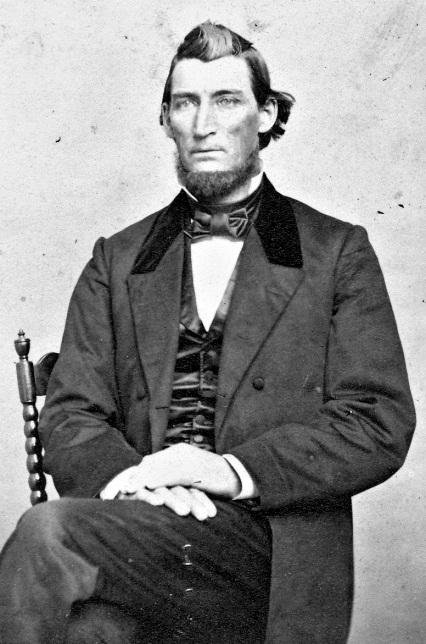
Solomon Foye
213 Washington Street
This mansard-roofed Victorian was built ca. 1870 for Rev. Isaac D. Stewart. This Baptist clergyman worked as the agent for the Free Will Baptist Printing Establishment. By 1888, the house was occupied by the Charles Hodsdon family. Hodsdon owned a jewelry store at 444 Central Avenue and employed his four children, Flora, George, Ida, and Augusta, there. Around 1900, the home was purchased by Dudley L. Furber, a shoe manufacturer which factories in Northwood, Farmington, and Dover. Furber held several patents for shoe designs including a special “Furber Bicycle Shoe.” In the 1920s the house was sold to Edward H. Quimby, owner of Quimby’s Typewriters, who lived here until the mid-50s.
220 WASHINGTON STREET/ 2 CUSHING STREET
This corner house has two addresses. Originally 220 washing Street, Charles W. Webb moved here about 1935 and operated a grocery store at 158 Washington. In the mid-1940s the back of this home became 2 Cushing Street. Vernon Webb lived there and took over the grocery store while Charles W. started an insurance and real estate business. A few years later Irving Webb took over the store and Vernon joined the insurance firm. The grocery went out of business about 1958.
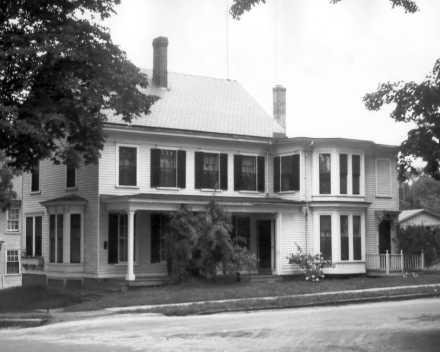
230 WASHINGTON STREET/ CUSHING HOMESTEAD
This brick homestead, built ca. 1850 by tycoon Thomas H. Cushing, is still owned, nearly a century and a half later, by descendants of Mr. Cushing. Thomas Hanson Cushing was born in Dover in 1805. He married, in 1824, Caroline Torr, and embarked on a highly successful career as a railroad bridge builder. Because railroads all over the country were expanding so rapidly, Cushing’s contracting and engineering skills were in great demand. He erected railroad bridges not only throughout New England for the B&M system but also in Maryland, Ohio, and Illinois. He also developed extensive real estate holdings in Dover: between 1841 and 1860 there were 57 deeds registered in his name; and he was proprietor of the Cocheco Planing, Sawing, and Turning Mill on Gulf Road.
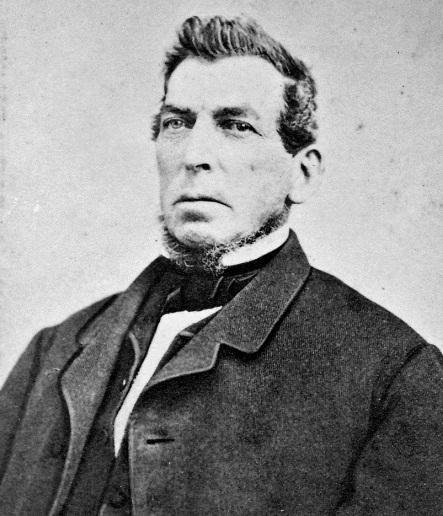
Thomas H. Cushing
In 1843, Cushing purchased the land for his Georgian-style home and most of the land between Washington and Silver Streets for $1400 from Elizabeth Coffin, and in 1850 bought more Coffin land for $125 more. His new home contained 17 rooms, most with 11 foot ceilings, and 6 fireplaces, four of which are marble while the windows on the front of the house measure 10 feet.
Thomas H. Cushing was also a member of the N.H. legislature, and at the time of his death in 1868, at age 62, was Dover’s highest taxpayer at $794.56. Thomas and Caroline had four children: Hannah Augusta 1848-1850, Thomas Edgar (1853-1884), Emma C. (1854-1928), and Sarah Abby (1856-1944). Thomas Edgar Cushing inherited the property and his mother remarried Judge Ezekiel Hurd, sheriff and associate justice for Strafford County, president of the Strafford Savings Bank, and cashier of the Cocheco National Bank. The Hurds continued to live here with Thomas, but the judge died in 1870, shortly after the wedding. Caroline lived to age 85 and died here in 1911. Thomas Edgar Cushing pre-deceased his mother, dying quite young at age 31 in 1884.
In 1912, the remaining heirs of Thomas H. Cushing sold the homestead to John H. Nealley, now the husband of Emma C. Cushing, Thomas’ daughter. The Nealleys also had lived here for over 25 years since their marriage. When they died, both in 1928, the property reverted to Frances E. Cushing, widow of Thomas Edgar, and to her sister-in-law, Sarah Cushing Malcolm, Thomas H. Cushing’s fourth child.
By 1944, the only surviving descendant of Thomas H. Cushing was a great-grandson, Thomas Cushing Dunnington of New York. Mr. Dunnington returned to Dover with his family and rebuilt and refurbished the home after several decades of inattention. The home is currently occupied by his son, Thomas C. Dunnington Jr. and his family. The home also serves as the law offices of Mr. Dunnington Jr.
11 And 15-17 Cushing Street
These two houses were built by the Mathes family. Valentine Mathes started a grocery on Folsom Street about 1882. This soon expanded to a business in coal, hay, grain, and fertilizer, and in 1889 valentine bought the lot at #11 from Robert Pike. The deed stipulated that only single or double tenements were to be built and Valentine built #11 soon after 1889.

Valentine Mathes
The lot for #15-17 was sold by Robert Pike to Oliver Gibbs in 1891 and Gibbs sold it to Mathes in 1913. Valentine died in 1915 and his widow Mary, son M. Everett, and daughter Fannie lived at #11. They soon built the house at #15-17 and M. Everett moved there about 1920. The Mathes business on Folsom Street evolved into a part of the Diamond National lumberyard which stayed in business there until about 1958. The buildings are now torn down.
When Mary Mathes died in 1934, Fannie lived at #11 and rented apartments in #15-17. She also rented other property on Central Ave. The Dover City Directories list her as having “real estate apartments and an interesting book collection of 1000s of volumes.” She also collected many other items and her house was virtually bursting at the seams. M. Everett moved to Littleworth Road and he and his brother formed the Mathes Bros. Real Estate and Insurance. Fannie died in 1964 and both properties were sold: #11 to Roy and Mary Marcotte and #15-17 to Ed and Jane Harrity. In the 1970s both houses were sold to mark and Marjorie Edmunds who reside at #11.
16 To 22 Cushing Street
Folsom Street was laid out through one of Thomas H. Cushing’s lots around 1870. A few years later the Portsmouth and Dover Railroad was added parallel to Cushing Street and the Folsom Railroad Station was built.
The Cushing lot next to Folsom Street was bought by E.V. Brewster who sold it to O.A. Gibbs in 1892. The two present buildings were erected on that lot. Oliver A. Gibbs lived up the street at #44, but Maurice Gibbs lived in #20 from about 1912 to 1926 when he moved to #44 also. Descendants Dora Perkins and her daughter Jo O’Neil still live in #20-22.
24-26 Cushing Street
This was a single house (as #24) built in the early 1870s by William Simes, a carpenter. His widow Amanda was here until about 1910. In 1917, Charles Hale moved here with his family. His wife Janet had a sister, Aimee Spiller and she moved here about 1924. It became a two-family house, the Hales in #24, and Mrs. Spiller in #26. Mother Spiller, as she was known, was a telephone operator for many years, and grew a yard full of fruit trees. She outlived the Hales and was here until the 1960s. Now the home is listed only as #26.
27 Cushing Street
Eli V. Brewster’s store on Central Avenue sold boots, shoes, and groceries. In the 1870s he built this house which eventually became the property of Freelove J. Brewster. In 1904, Freelove sold it to his nephew Frank L. Hayes with the stipulation that Freelove could always live here and Frank would care for his every need. Frank was a house and fresco painter, decorator, and wallpaper hanger. Evidently Frank Hayes didn’t have to tend Freelove for very long because in 1909 he sold the house to the American Woolen Company. The company used it as housing for their agent, A.B. Paton.
The house was sold in 1932 to Frank Page and again in 1943 to Niclis Kouloungis whose family was here until recent years when the estate was sold and divided into condominiums.
30 Cushing Street
The 1871 Dover map shows only two houses on this side of the street between Folsom and Silver. This home is marked “O. Brock” and one at the corner marked “Mrs. M.A. Nutter.”
Oliver Brock bought this house lot from the Cushing’s in 1869. Needing to raise $10,000, Mrs. Cushing auctioned off many of the house lots bordering what are now Cushing and Lexington Streets. Brock purchased this one for $330 and built this home soon after.
32-34 Cushing Street
Asa J. Pinkham and Almon L. York jointly purchased this lot in 1873 for $600. They evidently bought a piece of property known as the Jones house and moved it onto the lot. It was intended that they share parts of the house because they agreed that the front door and hall, the front stairs, back stairs and cellar stairs were to be used in common. Asa owned the north half of the lot and Almon the southern half.
In 1888, Almon sold his half to John Canavan and the Pinkhams and Canavans lived here for many years. In the late 1920s Wallace and Marion Varney lived here also. She lived here until about 15 years ago.
29-31 Cushing Street
Charles Murphy sold land with buildings thereon to Dr. Henry Rust Parker in 1884 for $8000. Dr. Parker started out as a penniless orphan at 12 years of age, pursued his studies and graduated from Dartmouth in 1865. He started a medical practice in Wolfeboro and came to Dover in 1881. The Parkers bought several other lots so their property reached to Lexington Street which was undeveloped at that time.
In 1881-82, Parker was Dover’s mayor and in 1900 his wife Ella formed the Northam Colonists Historical Society here. She was the group’s first president. Henry Parker died in 1909, but Ella lived here until ca. 1940. Winfield S. Leighton moved in then, and Mary Leighton still lives here.
35 Cushing Street
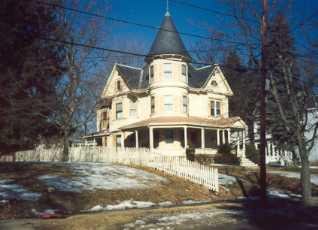
In 1878 Charles Murphy sold this lot to Maria Tasker for $1000 and Charles W. Tasker began living here in 1898. He was a dentist who had set up practice in Dover about 1869. Dr. Tasker died in 1923, but the house had been sold in 1919 to Fred Ireland. Fred’s widow Nellie sold it in 1930 to Fred Richardson, an insurance agent.
Subsequent owners were Edward and Jeanne Hutchinson (1957), John and Shirley Topham (1961), Charles and Barbara Smith (1968) and currently, Joseph and Patricia Schrio (1971). Mr. Schiro is a psychotherapist, his wife a teacher, and their daughter Cathy Schiro O’Brien, is perhaps becoming the most famous person to live here. A cross-country champion in high school, Cathy, now 22, is a world-class long distance runner who participated in the Seoul Olympic Games.
40 Cushing Street
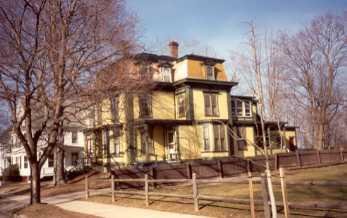
W.H. Vickery, proprietor of an apothecary shop, bought this lot in 1870 and built this home soon after. John Kivel bought the house in 1893. He was a lawyer and notary public and also a Superior Court judge. His daughter Alice, a legal secretary, lived here until around 1950. Ambrose Breen, Dover’s mayor—1973, lived here for a few years around 1960.
39-41 Cushing Street
James Bunker purchased this lot in 1869 from the Thomas H. Cushing estate and built this double house. In 1873, he sold his homestead to Mrs. I.B. (Hannah) Williams, with the stipulation clearly spelled out that it would be “free of Isaac Williams’ control.” Isaac died in 1885 and Hannah lived here until 1933. It was then rented until Joseph Smiley bought it in 1945. Joseph had a daughter, Ruth, a music teacher for many Dover youths, who lived in #41 until 1980.
44-46 And 48 Cushing Streets
This was the Gibbs family homestead for a number of years. Oliver Azro Gibbs Sr., a veterinary surgeon, was here as early as 1882. Gibbs died in 1893 and his sons O.A. JR., Maurice, and Fred lived here. O.A. Jr. was president of the O.A. Gibbs Shoe Company on Grove Street and Maurice was the secretary. Fred was a dentist, first in Somersworth, then in Dover’s Masonic Temple. Mrs. Florence Dame inherited the house and lived here briefly before selling it. The barn was renovated to make two apartments and became #48 about 1952.
5O Cushing Street
George S. Smith, carriage trimmer, lived here in the latter part of the 1800s. In 1941, Nicholas Koutrelakos, owner of Nick’s Lunch at Central Square, bought the house and brought his large family here. Nicholas died about 1967 and his widow Triathi lived here until 1982. The house was then sold, the family members living in other parts of the city.
103 Silver Street
This home was built in 1871 by Mr. E.C. Kinnear, a shoe manufacturer. By 1890, it was home to Frank B. and Mary Williams. Frank was the son of leather belting manufacturer. I.B. Williams and worked in his father’s factory. Isaac B. Williams had come to Dover as an apprentice to his uncle James Hill in 1835. Capt. Hill ran a belt-making business in the old Nail Factory on Central Street. By 1842, I.B. was the head of this business, now located in Mill #4 of the Cocheco mill quadrangle. The expanding I.B. Williams Co. outgrew its quarters and moved to a shoe factory on Orchard St. in 1875.
After I.B.’s death in 1885, Frank enlarged the premises again, developing a 4-story factory with 70,000 feet of floor space and $2 million in sales worldwide.
This large Victorian home was owned by Mary Williams after Frank’s death in 1920, and later by their two daughters until the late 1970s. It is currently an 11-room bed and breakfast establishment, the Silver Street inn, and features leaded glass windows, marble baseboards, slate and parquet floors, carved plaster ceilings, and paneled mahogany walls.
The Williams’ two daughters, Marguerite and Dorothy, married men with the same last name: Brown, although the gentlemen were not related. Marguerite married Philip c. brown and moved to 98 Silver. Dorothy married LeRoy H. Brown and also lived close by at 107 Silver Street.
After Mary Williams’ death in 1946 and Leroy’s in 1948, Dorothy moved back to 103 Silver Street. After she died, the house was sold in 1978 to Jordan and Braxton Carr of Nashville. The Carrs sold the home present owner Lorene L. Cook in 1987.
107 Silver Street
The Younger daughter of Frank B. and Mary Williams was Dorothy, born in 1894. She married LeRoy H. Brown in 1920 and they purchased this home from Daniel E. Hanson whose family had owned this land since the late 1700s. LeRoy Brown went to work as treasurer of his father-in-law’s company, I.B. Williams and Sons Belt Factory. After LeRoy died in 1948, Dorothy moved back to her childhood home at #103 as co-owner with sister Marguerite. In 1950, Marguerite sold her share to Dorothy. Present owners of #107 are George & Gloria Perrine.
98 Silver Street
This home was built ca. 1892 for Frank B. Williams on the site of the Old Strafford County jail. In 1826, proposals for a new jail on Silver Street were submitted. The old Gaol on Central Street had served for 60 years and was obsolete. The new facility would be made of stone, with a brick house for a jailor attached, and a large exercise yard. It would all be surrounded by a high fence. The new jail was completed by 1827 and later, in 1846, was the site of Dover’s second (and last) execution by hanging. Gallows for Andrew Howard, convicted murderer of Phebe Hanson, were set up at the rear of the jail and on July 8, some 3000 spectators gathered to watch. A circus-like atmosphere prevailed with vendors selling gingerbread, lemonade and peanuts. It was because of this crowded, almost riotous occasion that the N.H. decreed all future executions would be at the State Prison.
As Silver Street developed, its new wealthy resident expressed their displeasure at having the jail so near their grand homes. So the facility was sold in 1888 for $5000. All prisoners were transferred to a new rotary jail on Lower Washington Street in 1889, and the prison here was torn down.
After Frank B. Williams’s daughter Marguerite married Philip C. Brown in June, 1909, this house became their home. Philip also went to work for his father-in-law, assuming the presidency of I.B. Williams Belt Company in 1926. He remained in that post until his death in 1960. After Marguerite’s death in 1981, the house was sold to the Carswell family.
108 Silver Street
Currently the home of Charles W. Colprit, this house was built before 1842, possibly by William and Lydia Blake who had purchased the land in 1808. 19.5 acres here were originally owned by a Ricker family until 1773, then by Hansons.
In 1880, Mehitable Twombly and Lucy Whitehouse sold the premises to Henry W. Twombly on the condition that Henry use the home for “the support and maintenance of Lydia Blake.” By 1887, Lydia had sold the house outright to Henry Twombly, and in 1925, Twombly heirs Ann J. Twombly and Grace T. Marshall resold the property to LeRoy Brown. Brown sold the house to Alvin A. and Louise Stevens, but in 1946 Louise J. Stevens sold it back to Brown. That same year, Brown sold the home again, this time to Carroll J. and Zella F. Newling subject to the agreement that if the Newlings desired to rent the property, the Browns could repurchase it. Mrs. Newling lived here until the late ‘60s. Her daughter is Mrs. Colprit.
114 Silver Street
Karen and Richard Moore purchased this home in 1984 from the Reilly family who bought it in 1982 from Mr. and Mrs. Thomas Smith. The Smiths had owned the house for about 25 years, acquiring it from the Christiansen family.
The house dates from ca. 1760-1780, and was originally occupied by N. Watson, a farmer who operated a tavern here. Later, a Mr. Bickord ran a tavern/hostelry here and coaches on the road from Boston to Concord stopped here. Bickford sold the home to John J. Hanson (1826-1894) ca. 1871 and Hanson’s children, Frank W. (1865-1918) and Carrie L. (1861-1933), inherited the house. Later, Lois Hanson (1907-1946) married Ernest Christensen, an athletic coach at UNH.
The Christiansens made many changes in the house: the morning room was taken out, doors, stairways and windows were rearranged, and the outside chimney and fireplace were added. The home’s cellar has a partial tunnel that once let to the duplex next door at #116-118. The property was farmed and there was an orchard and several outbuildings connected to the house. What appears to be a center chimney is in fact a split chimney that goes up either side of the main staircase and rejoins in the attic to form one main stack.
116-118 Silver Street
This duplex was built ca. 1888 on land originally owned by John J. Hanson. The home was constructed for two Hanson daughters, one of whom, Alice (1858-1932), became Mrs. Charles H. Farnham. Farnham (1855-1935) was the owner of Lothrop’s, Farnham Clothing Company until his death. Harry L. Farnham continued to live at #116 until his 1972 death.
The carriage house behind #114 and this duplex was built to house Jojn J. Hanson’s horses; and the families also kept pigs in the cellar there. Whenever there was heavy rainfall, the basement would flood and the pigs would drown. So a drainage system was installed and the cisterns and wells still exist behind the properties. The system was very well designed as present owners of #114 report that the cellar is very dry and the backyard gardens have excellent drainage.
117 Silver Street
In 1861, Samuel Fisher bought this land from Thomas H. Cushing and in 1865-66, Fisher sold this lot at the corner of Silver and Lexington (then called Prospect St.) to Joshua Hall. The house was built between 1865 and 1871.
Joshua G. Hall (1828-1898), Dartmouth graduate, was admitted to the N.H. bar in 1855. He resided in Dover from 1857 until his death. During his illustrious career he served as county and city solicitor, mayor of Dover, State Senator and Representative to the General Court, U.S. Attorney for N.H., and member of the 46th & 47th Congresses of the U.S.
Dwight Hale Hall (1871-1963), Joshua’s only son, inherited this home and carried on his father’s legal practice. He too graduated from Dartmouth; Dwight was admitted to the N.H. bar in 1897. After his death in 1963, the home was left to his sister Susan’s children, Jonathan Sawyer and Elizabeth B. Sawyer. It was later owned by another Dover attorney, Anthony McManus, in the late 1960s, but in the 1980s was converted to condominiums. This development upset abutters and led to the rezoning of this area so that no more such conversions occur.
120 Silver Street
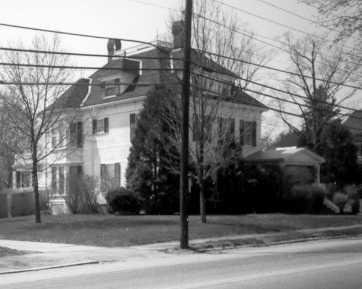
In 1889, Almanzor Towle sold this parcel of land to Thomas H. and Mary Dearborn and the home was built soon after. Dearborn (1860-1932) had owned a dry goods and department store in Dover since 1884. In 1909, he was also head of the N.H. Gipsey Moth Commission and by 1917, owner of “The Fashion,” a ladies garment store at 382 Central Ave. For the last 8 years of his life he served as Dover’s postmaster.
S. Judson Dunaway, owner of Expello Corp. and Dover philanthropist, bought the house in 1946 from Mary Dearborn. Dunaway sold it in 1950 to Howard and Grace Mitchell. The present owner, David C. Dopp, acquired the house in 1969.
125 Silver Street

This lot, part of Robert Christy estate until it was subdivided in 1895, was purchased by Sarah A. Ham Glass for her niece Mary Edith Ricker Gallagher and her husband James. By 1897, the Gallagher’s were occupying their new home here. In 1898, Mary Edith fell off a horse and died of peritonitis; James then sold the home in 1903 to Dwight Hall.
Mary Edith’s mother, Mary Abby Ham Ricker, bequeathed her estate for the construction of a memorial chapel in honor of her deceased daughter. Ricker Memorial Chapel, located in Pine Hill Cemetery, was completed in October 1912.
In 1908, Dwight Hall sold the house to William Hall Roberts, Clerk of Court and direct descendant of one of Dover’s first settlers, Thomas Roberts. Mr. Roberts and wife Lila Burgess had two children, Wade and Wilma. Wilma Roberts Thorin Sowerby taught for many years at the Varney School and still resides in Dover. Present owner is Raymond Hennessey.
127-129 Silver Street

Owned since 1952 by the John Foley family, this home was standing before 1778. Most of the original home was destroyed in an 1825 fire but it was rebuilt in 1826 by owner Elisha Woodbury. For many years it stood alone on Plum Pudding Hill (“the high ground between Lexington and Arch in Dover City”) and served as a tavern called “Farmers’ Hotel” with livery stables, a bowling green, and a carriage-roofed barn that has been preserved. Woodbury sold to Nathan Clark of Somersworth in 1832, and he, and his widow Mary Jane after him, ran “Ye Clarke’s Tavern” here until 1851. A large beech tree thrives now where the Lavern was located and the Woodman Institute has possession of a lawn bowling ball from Clarke’s Tavern.
Robert Christy bought the property in 1851 and lived here nearly 40 years. The home then passed through several owners, being Victorianized somewhat during the 19th century. Several of the 8 fireplaces (5 of which still work) are decorated formally in imported Italian tile.
Around 1921, the Hopkins family sold the house to Charles and Caroline Eaton and the ell was extended and remodeled. A columned patio was added on the east side. The tavern fireplace in the kitchen was restored by the present owners in 1969, and a rare Camperdown elm still lives on the front lawn, imported long ago from Europe.
136 Silver Street
Michael and Tessa McDonnell purchased this home in 1983 from Karl Friese. Mr. Friese bought it in 1955 from Bernadette J. Bernard, owner of Bernard’s Millinery, and the present owners report they still find an occasional hat pin in the attic. Mrs. Bernard acquired the home in 1929 from Adelaide F. Corson and Mildred T. Peabody.
Adelaide was the granddaughter of Almanzor Towle, an earlier owner of lots of real estate here. In 1926, Annie M. Towle lived here: she was the widow of George F. Towle (1839-1920), Almanzor’s brother. From 1895-1919, the house was lived in by Fannie Z. Towle, Almanzor’s sister, and as early as 1859, John W. Towle, a farmer, lived at this location.
137 Silver Street
The “little house” amid the larger Victorian homes that characterize much of Silver Street has actually 9 good-sized rooms, connects to a country barn, and sits on almost an acre and a half of city-proper land.
Present owner Myrtle A. Allen, for 45 years a well-known teacher in local schools, acquired the property in 1955 from Ralph and Nancy Fritch. The house was built during the Civil War after Robert Towle deeded land to Almanzor Towle in 1860. Land with buildings were sold in 1865 to painter John Laskey, in 1871 to L.R. Burlingame, publisher of the Morning Star newspaper. Prior to Allen occupation, the home was owned by Elder, Bascom, Morris and Fritch families, all of whom continued to upgrade the property. Myrtle Allen restored the wide-board pine floors and landscaped the yard including a beautiful red-leafed oriental maple on the front lawn.

This historical essay is provided free to all readers as an educational service. It may not be reproduced on any website, list, bulletin board, or in print without the permission of the Dover Public Library. Links to the Dover Public Library homepage or a specific article's URL are permissible.
